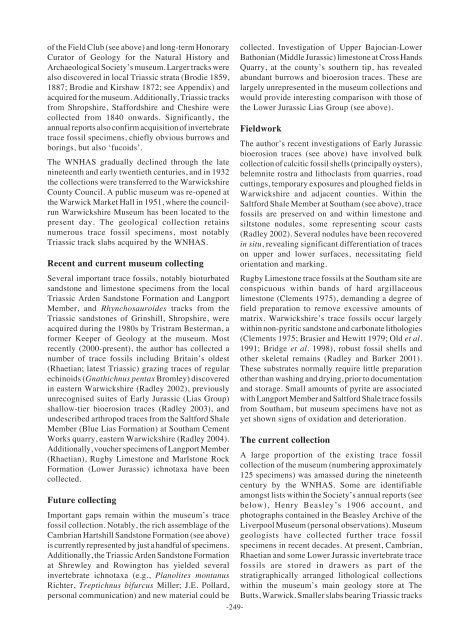Continental trace fossils and museum exhibits - Geological Curators ...
Continental trace fossils and museum exhibits - Geological Curators ...
Continental trace fossils and museum exhibits - Geological Curators ...
You also want an ePaper? Increase the reach of your titles
YUMPU automatically turns print PDFs into web optimized ePapers that Google loves.
of the Field Club (see above) <strong>and</strong> long-term HonoraryCurator of Geology for the Natural History <strong>and</strong>Archaeological Society’s <strong>museum</strong>. Larger tracks werealso discovered in local Triassic strata (Brodie 1859,1887; Brodie <strong>and</strong> Kirshaw 1872; see Appendix) <strong>and</strong>acquired for the <strong>museum</strong>. Additionally, Triassic tracksfrom Shropshire, Staffordshire <strong>and</strong> Cheshire werecollected from 1840 onwards. Significantly, theannual reports also confirm acquisition of invertebrate<strong>trace</strong> fossil specimens, chiefly obvious burrows <strong>and</strong>borings, but also ‘fucoids’.The WNHAS gradually declined through the latenineteenth <strong>and</strong> early twentieth centuries, <strong>and</strong> in 1932the collections were transferred to the WarwickshireCounty Council. A public <strong>museum</strong> was re-opened atthe Warwick Market Hall in 1951, where the councilrunWarwickshire Museum has been located to thepresent day. The geological collection retainsnumerous <strong>trace</strong> fossil specimens, most notablyTriassic track slabs acquired by the WNHAS.Recent <strong>and</strong> current <strong>museum</strong> collectingSeveral important <strong>trace</strong> <strong>fossils</strong>, notably bioturbateds<strong>and</strong>stone <strong>and</strong> limestone specimens from the localTriassic Arden S<strong>and</strong>stone Formation <strong>and</strong> LangportMember, <strong>and</strong> Rhynchosauroides tracks from theTriassic s<strong>and</strong>stones of Grinshill, Shropshire, wereacquired during the 1980s by Tristram Besterman, aformer Keeper of Geology at the <strong>museum</strong>. Mostrecently (2000-present), the author has collected anumber of <strong>trace</strong> <strong>fossils</strong> including Britain’s oldest(Rhaetian; latest Triassic) grazing <strong>trace</strong>s of regularechinoids (Gnathichnus pentax Bromley) discoveredin eastern Warwickshire (Radley 2002), previouslyunrecognised suites of Early Jurassic (Lias Group)shallow-tier bioerosion <strong>trace</strong>s (Radley 2003), <strong>and</strong>undescribed arthropod <strong>trace</strong>s from the Saltford ShaleMember (Blue Lias Formation) at Southam CementWorks quarry, eastern Warwickshire (Radley 2004).Additionally, voucher specimens of Langport Member(Rhaetian), Rugby Limestone <strong>and</strong> Marlstone RockFormation (Lower Jurassic) ichnotaxa have beencollected.Future collectingImportant gaps remain within the <strong>museum</strong>’s <strong>trace</strong>fossil collection. Notably, the rich assemblage of theCambrian Hartshill S<strong>and</strong>stone Formation (see above)is currently represented by just a h<strong>and</strong>ful of specimens.Additionally, the Triassic Arden S<strong>and</strong>stone Formationat Shrewley <strong>and</strong> Rowington has yielded severalinvertebrate ichnotaxa (e.g., Planolites montanusRichter, Treptichnus bifurcus Miller; J.E. Pollard,personal communication) <strong>and</strong> new material could be-249-collected. Investigation of Upper Bajocian-LowerBathonian (Middle Jurassic) limestone at Cross H<strong>and</strong>sQuarry, at the county’s southern tip, has revealedabundant burrows <strong>and</strong> bioerosion <strong>trace</strong>s. These arelargely unrepresented in the <strong>museum</strong> collections <strong>and</strong>would provide interesting comparison with those ofthe Lower Jurassic Lias Group (see above).FieldworkThe author’s recent investigations of Early Jurassicbioerosion <strong>trace</strong>s (see above) have involved bulkcollection of calcitic fossil shells (principally oysters),belemnite rostra <strong>and</strong> lithoclasts from quarries, roadcuttings, temporary exposures <strong>and</strong> ploughed fields inWarwickshire <strong>and</strong> adjacent counties. Within theSaltford Shale Member at Southam (see above), <strong>trace</strong><strong>fossils</strong> are preserved on <strong>and</strong> within limestone <strong>and</strong>siltstone nodules, some representing scour casts(Radley 2002). Several nodules have been recoveredin situ, revealing significant differentiation of <strong>trace</strong>son upper <strong>and</strong> lower surfaces, necessitating fieldorientation <strong>and</strong> marking.Rugby Limestone <strong>trace</strong> <strong>fossils</strong> at the Southam site areconspicuous within b<strong>and</strong>s of hard argillaceouslimestone (Clements 1975), dem<strong>and</strong>ing a degree offield preparation to remove excessive amounts ofmatrix. Warwickshire’s <strong>trace</strong> <strong>fossils</strong> occur largelywithin non-pyritic s<strong>and</strong>stone <strong>and</strong> carbonate lithologies(Clements 1975; Brasier <strong>and</strong> Hewitt 1979; Old et al.1991; Bridge et al. 1998), robust fossil shells <strong>and</strong>other skeletal remains (Radley <strong>and</strong> Barker 2001).These substrates normally require little preparationother than washing <strong>and</strong> drying, prior to documentation<strong>and</strong> storage. Small amounts of pyrite are associatedwith Langport Member <strong>and</strong> Saltford Shale <strong>trace</strong> <strong>fossils</strong>from Southam, but <strong>museum</strong> specimens have not asyet shown signs of oxidation <strong>and</strong> deterioration.The current collectionA large proportion of the existing <strong>trace</strong> fossilcollection of the <strong>museum</strong> (numbering approximately125 specimens) was amassed during the nineteenthcentury by the WNHAS. Some are identifiableamongst lists within the Society’s annual reports (seebelow), Henry Beasley’s 1906 account, <strong>and</strong>photographs contained in the Beasley Archive of theLiverpool Museum (personal observations). Museumgeologists have collected further <strong>trace</strong> <strong>fossils</strong>pecimens in recent decades. At present, Cambrian,Rhaetian <strong>and</strong> some Lower Jurassic invertebrate <strong>trace</strong><strong>fossils</strong> are stored in drawers as part of thestratigraphically arranged lithological collectionswithin the <strong>museum</strong>’s main geology store at TheButts, Warwick. Smaller slabs bearing Triassic tracks
















